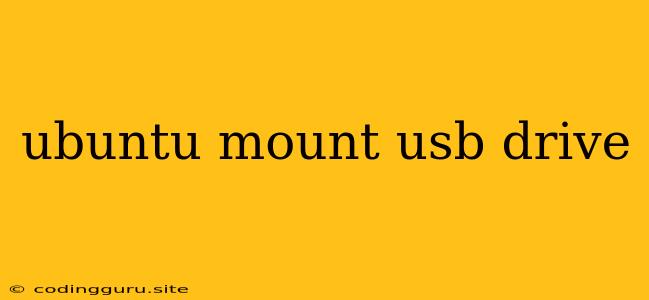How to Mount a USB Drive in Ubuntu
Connecting a USB drive to your Ubuntu system is a straightforward process, but sometimes you might encounter issues mounting it. This article will guide you through the steps of mounting a USB drive in Ubuntu, covering both the basic procedure and troubleshooting tips.
Understanding the Basics
Before we dive into the details, let's clarify what mounting a USB drive means. When you connect a USB drive to your computer, the operating system needs to make it accessible. This is achieved through the mount command, which establishes a connection between the USB drive and your file system.
Methods to Mount a USB Drive
There are several ways to mount a USB drive in Ubuntu:
1. Using the Files App:
This is the simplest and most user-friendly approach, especially for beginners.
- Connect your USB drive: Plug it into a free USB port on your computer.
- Open the Files App: Click on the Files icon in the Ubuntu dock or press Ctrl + Alt + T to open a terminal and type nautilus.
- Locate your USB drive: It should appear under "Removable Devices" in the left pane.
- Double-click the drive icon: This will open your USB drive in a new window, allowing you to access its contents.
2. Using the Disk Utility:
This method provides more control over the mounting process and allows you to format or partition the drive if needed.
- Open Disk Utility: Search for "Disks" in the Ubuntu Dash or open a terminal and type gnome-disks.
- Identify your USB drive: Look for the drive listed under "Removable Devices" in the Disk Utility window.
- Mount the drive: Click on the "Mount" button next to the drive's name.
3. Using the Command Line:
This approach offers the most flexibility and control over the mounting process.
- Open a terminal: Press Ctrl + Alt + T to open a terminal window.
- List available drives: Execute the command sudo fdisk -l to list all connected drives.
- Identify your USB drive: Look for the drive with the correct size and label.
- Mount the drive: Use the command sudo mount /dev/sdX /mnt/usb where
/dev/sdXis the identifier of your USB drive and/mnt/usbis the mount point you want to use. - Create the mount point: If the mount point doesn't exist, create it using the command sudo mkdir /mnt/usb.
4. Auto-mounting:
You can configure your system to automatically mount your USB drive upon connecting it.
- Open the Files App: Click on the Files icon in the Ubuntu dock.
- Go to "Other Locations": Click on "Other Locations" in the left pane.
- Open "Mount Settings": Double-click on "Mount Settings".
- Select "Automount" option: Choose the "Automount" option for your USB drive and click "Apply".
Troubleshooting Mounting Issues
If you encounter problems mounting your USB drive, here are some potential solutions:
- Check the USB port: Try plugging your USB drive into a different port on your computer.
- Verify permissions: Make sure you have sufficient permissions to access the drive. You can use the sudo command to gain root access.
- Unplug and replug: Disconnect the USB drive and plug it back in.
- Check the drive's file system: Ensure the file system is compatible with Ubuntu. Use the command lsblk to check the file system.
- Reformat the drive: If all else fails, you may need to reformat the drive with a compatible file system. You can use the Disk Utility for this purpose.
Key Points:
- Always unmount the USB drive before disconnecting it: This ensures data integrity and prevents corruption. You can unmount the drive using the "Unmount" button in the Disk Utility, the Files App, or the command sudo umount /mnt/usb.
- Choose a suitable mount point: While
/mnt/usbis a common mount point, you can choose any directory you prefer. - Explore the power of the command line: The command line offers the most control and flexibility in mounting USB drives.
Conclusion:
Mounting a USB drive in Ubuntu is a simple and straightforward process. By following the steps outlined above, you can successfully access the data on your USB drive. Remember to check for any errors and troubleshoot any problems that might arise.
